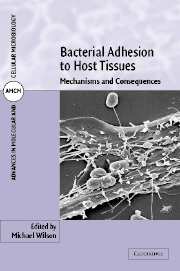Book contents
- Frontmatter
- Contents
- List of contributors
- Preface
- Part I Bacterial adhesins and adhesive structures
- Part II Effect of adhesion on bacterial structure and function
- Part III Consequences of bacterial adhesion for the host
- 10 Adhesion, signal transduction and mucosal inflammation
- 11 Adhesion of oral spirochaetes to host cells and its cytopathogenic consequences
- 12 Interactions between enteropathogenic Escherichia coli and epithelial cells
- 13 Host cell responses to Porphyromonas gingivalis and Actinobacillus actinomycetemcomitans
- Index
- Plate section
13 - Host cell responses to Porphyromonas gingivalis and Actinobacillus actinomycetemcomitans
Published online by Cambridge University Press: 08 October 2009
- Frontmatter
- Contents
- List of contributors
- Preface
- Part I Bacterial adhesins and adhesive structures
- Part II Effect of adhesion on bacterial structure and function
- Part III Consequences of bacterial adhesion for the host
- 10 Adhesion, signal transduction and mucosal inflammation
- 11 Adhesion of oral spirochaetes to host cells and its cytopathogenic consequences
- 12 Interactions between enteropathogenic Escherichia coli and epithelial cells
- 13 Host cell responses to Porphyromonas gingivalis and Actinobacillus actinomycetemcomitans
- Index
- Plate section
Summary
INTRODUCTION
The area of contact between the teeth and the gums (gingiva) is an anatomically unique region that comprises mineralized tissue embedded in epithelium and exposed to a microbially abundant environment. The small (1–4mm deep) gap between the surfaces of the tooth and the gingiva is known as the gingival sulcus or crevice. The gingiva is highly vascularized and the crevice is lined with sulcular epithelial cells that differ from oral epithelial cells by exhibiting less keratinization. Apically, sulcular epithelium becomes junctional epithelium that is characterized by a lack of keratinization, limited differentiation and a relatively permeable structure. It is this junctional epithelium that directly interposes between the gingiva and the tooth surface (Fig. 13.1). In destructive periodontal disease there is migration of the junctional epithelium resulting in enlargement of the crevice into a deeper periodontal pocket that contains inflammatory cells such as neutrophils and T-cells. The gingiva itself also contains immune cells including B-cells, T-cells and dendritic cells. The microbiota of the gingival area in both health and disease is complex, with at least 500 species of bacteria present in the gingival crevice. Although many of these have pathogenic potential, the strongest causal associations have been demonstrated between Porphyromonas gingivalis and severe adult periodontitis, and between Actinobacillus actinomycetemcomitans and localized juvenile periodontitis.
Many factors contribute to the maintenance or disruption of the ecological balance in the subgingival area. The immunological status of the host, the relative and absolute numbers of specific organisms or groups of organisms, and environmental parameters such as tobacco use, all play a role in determining gingival health or disease (Socransky and Haffajee, 1992).
- Type
- Chapter
- Information
- Bacterial Adhesion to Host TissuesMechanisms and Consequences, pp. 299 - 322Publisher: Cambridge University PressPrint publication year: 2002
- 1
- Cited by



